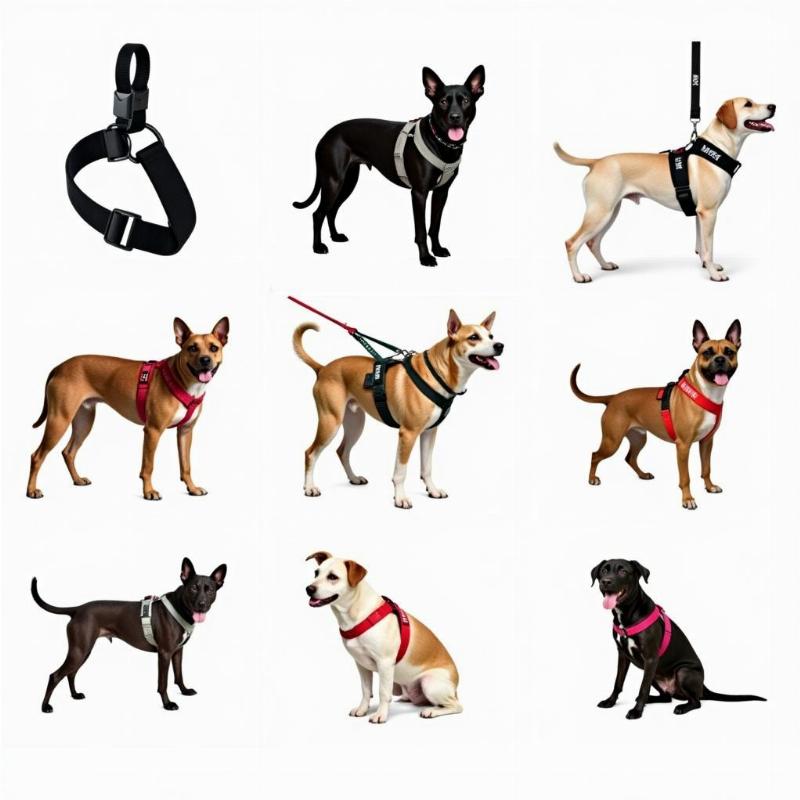A dog harness for hip dysplasia can significantly improve your furry friend’s comfort and mobility. Choosing the right harness can be a game-changer, offering support and stability while reducing pain and strain on their hips. This guide provides a deep dive into selecting and using the perfect harness for your dog’s needs, ensuring their well-being and enhancing their quality of life.
Understanding the Importance of a Dog Harness for Hip Dysplasia
Hip dysplasia is a common and often debilitating condition affecting many dogs, particularly larger breeds. This degenerative joint disease causes pain, stiffness, and reduced mobility, making everyday activities challenging. A properly fitted harness can alleviate these issues by providing crucial support and distributing weight evenly, reducing pressure on the affected hips. This can be especially beneficial for senior dogs or those recovering from surgery.
What are the key benefits of using a dog harness for hip dysplasia? They offer support during walks, assist with standing and climbing stairs, and can even help prevent further hip deterioration. Choosing the right harness is vital for maximizing these benefits.
 Choosing a harness for dogs with hip dysplasia
Choosing a harness for dogs with hip dysplasia
Choosing the Right Harness for Your Dog’s Needs
Several factors play a crucial role in selecting the best harness for a dog with hip dysplasia. The harness should provide adequate support without restricting movement. Consider your dog’s size, breed, and the severity of their condition. dog harness for large dogs with hip dysplasia
Key Features to Look For:
- Lifting Handles: These provide assistance when your dog needs help getting up or navigating stairs.
- Padded Support: Ensures comfort and reduces pressure points.
- Adjustable Straps: Allow for a customized fit and accommodate changes in your dog’s condition.
- Durable Material: A strong and well-made harness will last longer and provide reliable support.
Different Types of Harnesses for Hip Dysplasia
Various harness types cater to dogs with hip dysplasia, each with its own advantages.
- Rear Support Harnesses: These harnesses are designed specifically to provide support to the hindquarters, helping dogs with weak back legs navigate stairs and other obstacles. dog harness for rear support
- Full Body Support Harnesses: These offer overall stability and support, making them ideal for dogs with more severe hip dysplasia or those recovering from surgery.
- Lifting Harnesses: Designed with strategically placed handles, these harnesses provide assistance lifting the dog’s rear end, making it easier for them to stand, walk, and navigate stairs. back leg harness for dogs
Which type of harness is best for your dog? It depends on their individual needs. Consult with your veterinarian for personalized recommendations. Dr. Emily Carter, a certified canine rehabilitation specialist, emphasizes, “The correct harness can drastically improve a dog’s mobility and comfort. A personalized assessment is crucial for optimal results.”
Fitting and Using the Harness Correctly
A properly fitted harness is essential for effectiveness and safety. The harness should be snug but not too tight, allowing for a comfortable range of motion. Ensure the straps are adjusted correctly and don’t rub or chafe.
Maintaining the Harness
Regular cleaning and inspection are essential to ensure the harness remains in good condition and continues to provide adequate support. Check for wear and tear, and replace the harness if necessary. max and neo dog collar
Conclusion
Investing in a dog harness for hip dysplasia can make a profound difference in your dog’s quality of life. By providing support, stability, and pain relief, the right harness can empower your dog to enjoy walks and daily activities with greater ease and comfort. Remember to consult with your veterinarian for personalized guidance and choose a harness that best suits your dog’s individual needs.
FAQ
- How do I know what size harness to get for my dog? Measure your dog’s chest girth and consult the manufacturer’s sizing chart for the specific harness model.
- Can a harness make hip dysplasia worse? No, a properly fitted harness can actually help alleviate pain and prevent further deterioration.
- What is the best type of harness for a senior dog with hip dysplasia? A lifting or full-body support harness can be especially beneficial for senior dogs.
- How often should I clean my dog’s harness? Clean the harness regularly, especially if it gets dirty or wet.
- Can a harness be used after hip dysplasia surgery? Yes, a harness can be very helpful during post-operative recovery.
- Is it okay to leave the harness on my dog all the time? It’s generally recommended to remove the harness when your dog is not active or supervised.
- How can I encourage my dog to wear a harness? Introduce the harness gradually and use positive reinforcement, such as treats and praise.
Related Articles:
Beautdogs.us is your premier online destination for all things dog-related in the USA. We offer expert advice on dog breeds, care, and product recommendations, catering to both new and seasoned dog owners. Whether you’re seeking guidance on choosing the right harness or exploring the latest trends in dog wellness, Beautdogs.us is your trusted resource. Contact us today for personalized support! Email: [email protected], Phone: +1 501-555-7529. Connect with Beautdogs.us for a happier, healthier canine companion.